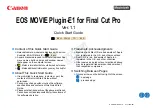
Director Basics
45
Director includes a set of prepackaged Lingo instructions, called behaviors, that you can simply
drag to sprites and frames. Behaviors let you add Lingo’s interactivity without writing Lingo
scripts. You can modify behaviors or create your own. For more information about the behaviors
included with Director, see “Using Director Behaviors” in the Director Support Center at
www.macromedia.com/support/director/lingo/d8/d8behaviors.html.
If you prefer writing scripts to using the Director interface and behaviors, Lingo provides an
alternative way to implement common Director features. For example, you can use Lingo to
create animation, stream movies from the web, perform navigation, format text, and respond to
user actions with the keyboard and mouse.
Writing Lingo also lets you do some things that the Score alone cannot do. For example, Lingo’s
lists let you create and manage data arrays, and Lingo operators let you perform mathematical
operations and combine strings of text.
For more general information about Lingo, see Chapter 16, “Writing Scripts with Lingo,”
on page 385.
Converting movies created in previous versions of Director
Director MX can convert movies from Director 7 and later. It’s not necessary to update movies
created in Director 8 or Director 8.5 for use in Director MX.
You can also update movies to Director MX by simply opening and saving them, but the Update
Movies command is faster for converting large projects. It’s also more effective for preserving links
to external media. See “Processing movies with Update Movies” on page 585.
Note:
Macromedia Shockwave Player 8.5 can play Shockwave movies created with Director 5, 6, 7, 8, and
Director MX.
When you open a Director 7 movie in Director MX or convert it to the new format with Update
Movies, the following changes occur to the movie:
•
The data structure is changed to the latest file format.
•
Shapes are not converted to the new Bézier shapes.
•
Ink functionality is not updated unless you turn off Maintain Outdated Ink Mode Limitations
in the Movie Properties dialog box.
•
Old Score data, from versions of Director before Director 5, is converted to the new Score,
combining adjacent frames in the old Score containing the same cast members into single
sprites in the new Score. You might want to split or join sprites to make working in the Score
more convenient.
Managing the Director authoring environment
While you work on a movie, you can use several optional controls and features to increase your
productivity. You can change preferences for Director interface functions and Internet connection
features, and you can print movies to see your work on paper. You can also monitor memory use
with the Memory inspector (Windows only).
Summary of Contents for DIRECTOR MX-USING DIRECTOR MX
Page 1: ...Using Director MX Macromedia Director MX...
Page 12: ...Contents 12...
Page 156: ...Chapter 4 156...
Page 202: ...Chapter 6 202...
Page 244: ...Chapter 7 244...
Page 292: ...Chapter 10 292...
Page 330: ...Chapter 12 330...
Page 356: ...Chapter 13 356...
Page 372: ...Chapter 14 372...
Page 442: ...Chapter 16 442...
Page 472: ...Chapter 18 472...
Page 520: ...Chapter 19 520...
Page 536: ...Chapter 20 536...
Page 562: ...Chapter 23 562...
Page 566: ...Chapter 24 566...
Page 602: ...Chapter 27 602...
















































